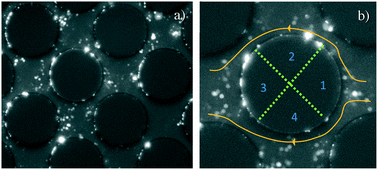Visualization of transport and fate of nano and micro-scale particles in porous media: modeling coupled effects of ionic strength and size†
Abstract
In this investigation, the single collector removal efficiency (η) of three latex nanoparticles differing in size (20, 200, 2000 nm) is presented for a 2-D micromodel system. The η for each collector grain as a whole and by quadrant was evaluated across a range of ionic strengths (1–100 mM KCl). Fluorescence microscopy allowed for the direct visualization of latex nanoparticle transport and deposition under the aforementioned ionic strengths and particle sizes. A rigorous numerical model was developed that incorporates DLVO forces (electrostatic and van der Waals interactions), as well as hydrodynamic forces utilizing COMSOL over the range of experimental conditions tested to calculate η. This expression, based on a modification of filtration theory, accounts for the observed variation in deposition with respect to the location (or quadrant) on the collector, ionic strength, and particle size. Visual and theoretical findings in this investigation confirm that the greatest deposition along the collector surface occurs at the rear stagnation region of an individual collector. In addition, the single collector removal efficiency increases with ionic strength as well as particle size. This research demonstrates the critical nature of the cumulative effects the hydrodynamic forces, size, and ionic strength have with respect to the interactions between particles and collectors.



 Please wait while we load your content...
Please wait while we load your content...